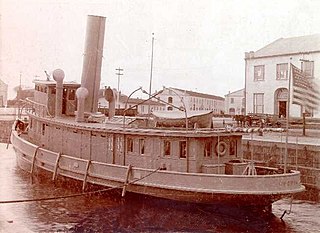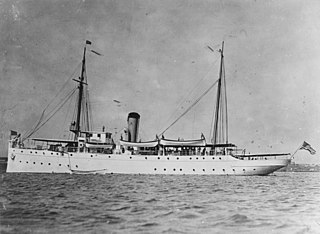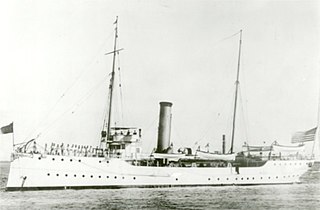
Joseph Francis Farley served as the ninth Commandant of the United States Coast Guard from 1946 to 1949. He was also the first Coast Guard officer to be issued a service number and held #1000 on the Coast Guard officer rolls.

Harry Gabriel Hamlet was the seventh Commandant of the United States Coast Guard, from 1932 to 1936.

Ellsworth Price Bertholf was a Congressional Gold Medal recipient who later served as the fourth Captain-Commandant of the United States Revenue Cutter Service and because of the change in the name of the agency in 1915, the fourth Commandant of the United States Coast Guard. His leadership during his tenure as Commandant was critical to the U.S. Coast Guard's survival at a time when outside agencies wanted to either take it over or split its missions up among several agencies.

USRC Windom was a revenue cutter of the United States Revenue Cutter Service and United States Coast Guard that served from 1896 to 1930. She was named for William Windom, the 33rd and 39th United States Secretary of the Treasury. She served during the Spanish–American War with the United States Navy. Windom was recommissioned as USCGC Comanche in 1915 and again served with the Navy as USS Comanche during World War I.

USS Bancroft was a United States Navy steel gunboat in commission from 1893 to 1898 and again from 1902 to 1905. She saw service during the Spanish–American War. After her U.S. Navy career, she was in commission in the United States Revenue Cutter Service from 1907 to 1915 as the revenue cutter USRC Itasca, and in the Revenue Cutter Service's successor service, the United States Coast Guard, as the cutter USCGC Itasca from 1915 to 1922. During her Coast Guard career, she saw service during World War I.

USRC Hudson, known for her service during the Battle of Cárdenas, was the United States Revenue Cutter Service's first vessel to have a steel hull and triple-expansion steam engine.

USCGC Androscoggin (WHEC-68) was an Owasco-class high endurance cutter built for World War II service with the United States Coast Guard. The war ended before the ship was completed and consequently Androscoggin did not see wartime service until the Vietnam war.

USCGC Ossipee (WPR-50) was a United States Coast Guard cutter of the Tallapoosa class constructed by Newport News Shipbuilding of Newport News, Virginia, and commissioned 28 July 1915. Her hull was strengthened for light icebreaking operations. She was assigned a homeport of Portland, Maine, after commissioning and cruised as far south as Cape Ann, Massachusetts, serving in a law enforcement and search and rescue capacity. She saw service in both World War I and World War II.

USCGC Tallapoosa (WPG-52) was a United States Coast Guard cutter of the Tallapoosa-class and was designed to replace the revenue cutter Winona. Her hull was reinforced for light icebreaking. She was initially stationed at Mobile, Alabama, with cruising grounds to Lake Pontchartrain, Louisiana, and Fowey Rocks, Florida. During World War I she escorted convoys out of Halifax, Nova Scotia. After the war she served with the Bering Sea Patrol before returning to Savannah, Georgia, before World War II. During the war Tallapoosa assisted with convoy escort duty and anti-submarine patrols.

USCGC Seneca, or before 1915 USRC Seneca, was a United States Coast Guard cutter built and commissioned as a "derelict destroyer" with the specific mission of locating and then destroying abandoned shipwrecks that were still afloat and were a menace to navigation. She was designed with excellent sea-keeping qualities, a long cruising range, good towing capabilities, and by necessity the capacity to store a large amount of munitions. She was one of five Coast Guard cutters serving with the U.S. Navy in European waters during World War I.

USCGC Tampa (ex-Miami) was a Miami-class cutter that initially served in the U.S. Revenue Cutter Service, followed by service in the U.S. Coast Guard and the U.S. Navy. Tampa was used extensively on the International Ice Patrol and also during the Gasparilla Carnival at Tampa, Florida and other regattas as a patrol vessel. It was sunk with the highest American naval combat casualty loss in World War I.

USRC Manning was a revenue cutter of the United States Revenue Cutter Service that served from 1898 to 1930, and saw service in the U.S. Navy in the Spanish–American War and World War I.

USCGC Point Welcome (WPB-82329) was an 82-foot (25 m) Point-class cutter constructed at the Coast Guard Yard at Curtis Bay, Maryland in 1961 for use as a law enforcement and search and rescue patrol boat.

USRC Onondaga was an Algonquin-class cutter built for the U.S. Revenue Cutter Service for service on the Great Lakes. Because of the Spanish–American War, she was cut in half shortly before completion and transported to Ogdensburg, New York for service on the Atlantic coast although the war ended before she could be put into service. After the formation of the United States Coast Guard in 1915 she became USCGC Onondaga. She served as a patrol vessel at various Atlantic coast ports before World War I and unlike most Coast Guard cutters during World War I, she remained under the control of the Commandant of the Coast Guard. After the war she patrolled for a brief time based at New London, Connecticut before being decommissioned in 1923.

USRC Mohawk, was a steel steam powered revenue cutter built for the U.S. Revenue Cutter Service by William R. Trigg Company at Richmond, Virginia. Her primary duties in the Revenue Cutter Service and Coast Guard were assisting vessels in distress and enforcing navigational laws as well as a derelict destroyer. Mohawk was sunk after a collision with another vessel in October 1917.

USRC Yamacraw, was a steel-hull flush-deck cutter that served in the United States Revenue Cutter Service from 1909 to 1937 and was the sister ship to the USRC Tahoma.
USCGC Point Grey (WPB-82324) was an 82-foot (25 m) Point class cutter constructed at the Coast Guard Yard at Curtis Bay, Maryland in 1961 for use as a law enforcement and search and rescue patrol boat. Since the Coast Guard policy in 1961 was not to name cutters under 100 feet (30 m) in length, it was designated as WPB-82324 when commissioned and acquired the name Point Grey in January 1964 when the Coast Guard started naming all cutters longer than 65 feet (20 m).

USRC Pamlico was a revenue cutter of the United States Revenue Cutter Service that served from 1907 to 1946 designed specifically to cruise inland waters and did so while stationed at New Bern, North Carolina her entire career.

USCGC Unalga (WPG-53) was a Miami-class cutter that served in the United States Revenue Cutter Service and later the U.S. Coast Guard and U.S. Navy. The early part of her career was spent patrolling the Pacific coast of the United States and the Bering Sea. After 1931 she did patrol work off Florida and in the Caribbean. After Unalga was sold in 1946, she was renamed after Jewish Agency leader Haim Arlosoroff and used for six months for moving Jewish refugees from Europe to Palestine before being forced to run aground by British Navy ships near Haifa.

USRC Algonquin was an Algonquin-class cutter built for the U.S. Revenue Cutter Service for service on the Great Lakes. Because of the Spanish–American War, she was cut in half shortly before completion and transported to Ogdensburg, New York for service on the Atlantic coast although the war ended before she could be put into service. She was homeported at San Juan, Puerto Rico from 1905 to 1917. Algonquin served briefly for the U.S. Navy along the Atlantic Coast in the summer of 1898 before being returned to the Treasury Department. After the formation of the United States Coast Guard in 1915 the vessel became USCGC Algonquin. The ship served as a patrol vessel at Norfolk, Virginia at the beginning of World War I before being assigned convoy duty in the Mediterranean. In February 1919 Algonquin was transferred to the West Coast and served in the Pacific Northwest and Alaska until being decommissioned at San Francisco in December 1930.



















